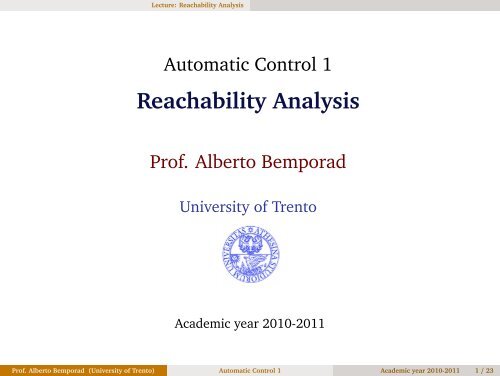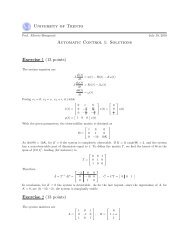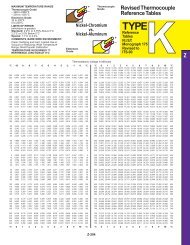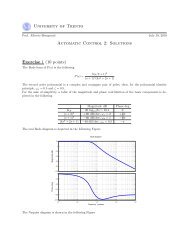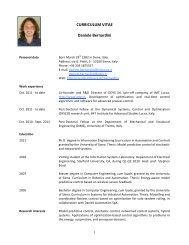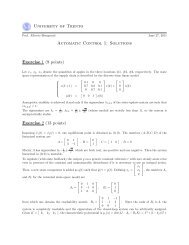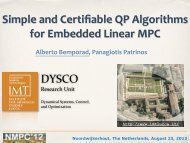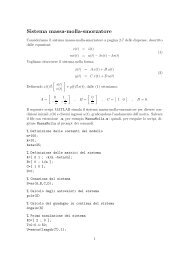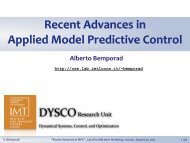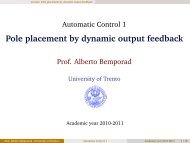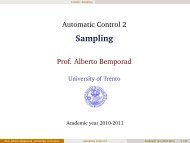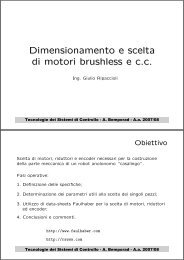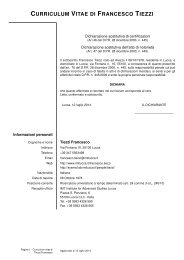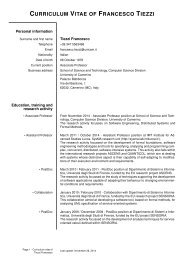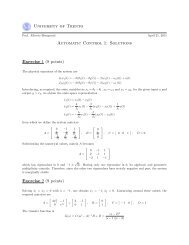Automatic Control 1 - Reachability Analysis
Automatic Control 1 - Reachability Analysis
Automatic Control 1 - Reachability Analysis
- No tags were found...
Create successful ePaper yourself
Turn your PDF publications into a flip-book with our unique Google optimized e-Paper software.
Lecture: <strong>Reachability</strong> <strong>Analysis</strong><strong>Automatic</strong> <strong>Control</strong> 1<strong>Reachability</strong> <strong>Analysis</strong>Prof. Alberto BemporadUniversity of TrentoAcademic year 2010-2011Prof. Alberto Bemporad (University of Trento) <strong>Automatic</strong> <strong>Control</strong> 1 Academic year 2010-2011 1 / 23
Lecture: <strong>Reachability</strong> <strong>Analysis</strong><strong>Reachability</strong> problem<strong>Reachability</strong>Consider the linear discrete-time systemx(k + 1) = Ax(k) + Bu(k)with x ∈ n , u ∈ m and initial condition x(0) = x 0 ∈ n∑k−1The solution is x(k) = A k x 0 + A j Bu(k − 1 − j)Definitionj=0The system x(k + 1) = Ax(k) + Bu(k) is (completely) reachable if ∀x 1 , x 2 ∈ n thereexist k ∈ and u(0), u(1), . . ., u(k − 1) ∈ m such that∑k−1x 2 = A k x 1 + A j Bu(k − 1 − j)j=0In simple words: a system is completely reachable if from any state x 1 we canreach any state x 2 at some time k, by applying a suitable input sequenceProf. Alberto Bemporad (University of Trento) <strong>Automatic</strong> <strong>Control</strong> 1 Academic year 2010-2011 2 / 23
Introduction to Your Washington Advance DirectiveThis packet contains a Washington Advance Directive, which protects your right torefuse medical treatment you do not want or to request treatment you do want in theevent you lose the ability to make decisions yourself. You may complete Part I, Part II,Part III, or any or all parts, depending on your advance-planning needs. You mustcomplete Part IV.Part I, Washington Durable Power of Attorney for Health Care, lets you namesomeone, called an “attorney-in-fact,” to make decisions about your health care—including decisions about life-sustaining treatments—if you can no longer speak foryourself. This is especially useful because it appoints someone to speak for you anytime you are unable to make your own health care decisions, not only at the end of life.Part I goes into effect when your doctor and one other doctor determine that you areno longer capable of making or communicating your health care decisions.Part II, Washington Declaration, lets you state your wishes about health care in theevent you cannot speak for yourself and you develop a terminal condition or you arepermanently unconscious.Part II goes into effect when your doctor and one other doctor determine that you areno longer capable of making or communicating your health care decisions and diagnoseyou in writing with a terminal condition or as permanently unconscious.Part III allows you to record your organ and tissue donation wishes.Part IV contains the signature and witnessing provisions so that your document will beeffective.This form does not expressly address mental illness. If you would like to make advancecare plans regarding mental illness, you should talk to your physician and an attorneyabout an advance directive tailored to your needs.Note: This document will be legally binding only if the person completing it is acompetent adult (at least 18 years old).3
Lecture: <strong>Reachability</strong> <strong>Analysis</strong>Linear algebra recallsAlgebraically equivalent systemsConsider the linear system x(k + 1) = Ax(k) + Bu(k)y(k) = Cx(k) + Du(k)x(0) = x 0Let T be invertible and define the change of coordinates x = Tz, z = T −1 x z(k + 1) = T −1 x(k + 1) = T −1 (Ax(k) + Bu(k)) = T −1 ATz(k) + T −1 Bu(k)y(k) = CTz(k) + Du(k)z 0 = T −1 x 0and hence z(k + 1) = Ãz(k) + ˜Bu(k)y(k) = ˜Cz(k) + ˜Du(k)z(0) = T −1 x 0The dynamical systems (A, B, C, D) and (Ā, ¯B, ¯C, ¯D) are called algebraicallyequivalentProf. Alberto Bemporad (University of Trento) <strong>Automatic</strong> <strong>Control</strong> 1 Academic year 2010-2011 4 / 23
Lecture: <strong>Reachability</strong> <strong>Analysis</strong><strong>Reachability</strong> <strong>Analysis</strong><strong>Reachability</strong>Let’s focus on the problem of determining a sequence of n inputs transferringthe state vector from x 1 to x 2 after n steps⎡x 2 − A n x} {{ } 1 = B AB . . . A n−1 B } {{ }⎢⎣XRu(n − 1)u(n − 2).u(0)⎤⎥⎦} {{ }UThis is equivalent to solve with respect to U the linear system of equationsRU = XThe matrix R ∈ n×nm is called the reachability matrix of the systemA solution U exists if and only if X ∈ Im(R)(Rouché-Capelli theorem: a solution exists ⇔ rank([R X]) = rank(R))Prof. Alberto Bemporad (University of Trento) <strong>Automatic</strong> <strong>Control</strong> 1 Academic year 2010-2011 8 / 23
Lecture: <strong>Reachability</strong> <strong>Analysis</strong><strong>Reachability</strong> <strong>Analysis</strong><strong>Reachability</strong>TheoremThe system (A, B) is completely reachable ⇔ rank(R) = nProof:(⇒) Assume (A, B) reachable, choose x 1 = 0 and x 2 = x. Then ∃k ≥ 0 such that∑k−1x = A j Bu(k − 1 − j)j=0If k ≤ n, then clearly x ∈ Im(R). If k > n, by Cayley-Hamilton theorem we haveagain x ∈ Im(R). Since x is arbitrary, Im(R) = n , so rank(R) = n.(⇐) If rank(R) = n, then Im(R) = n . Let X = x 2 − A n x 1 andU = u(n − 1) ′ . . . u(1) ′ u(0) ′ ′ . The system X = RU can be solved with respect toU, ∀X, so any state x 1 can be transferred to x 2 in k = n steps. Therefore, thesystem (A, B) is completely reachable.Prof. Alberto Bemporad (University of Trento) <strong>Automatic</strong> <strong>Control</strong> 1 Academic year 2010-2011 9 / 23
Lecture: <strong>Reachability</strong> <strong>Analysis</strong><strong>Reachability</strong> <strong>Analysis</strong>Comments on the reachability propertyThe reachability property of a system only depends on A and BWe therefore say that a pair (A, B) is reachable ifrank B AB . . . A n−1 B = nMATLAB» R=ctrb(A,B)» rank(R)Im(R) is the set of states that are reachable from the origin, that is the set ofstates x ∈ n for which there exists k ∈ and u(0), u(1), . . ., u(k − 1) ∈ msuch that∑k−1x = A j Bu(k − 1 − j)j=0If Im(R) = n , a system is completely reachable ⇔ all the states arereachable from the origin in n steps (proof: set x = x 2 − A n x 1 )Prof. Alberto Bemporad (University of Trento) <strong>Automatic</strong> <strong>Control</strong> 1 Academic year 2010-2011 10 / 23
Lecture: <strong>Reachability</strong> <strong>Analysis</strong><strong>Reachability</strong> <strong>Analysis</strong>Minimum-energy controlLet (A, B) reachable and consider steering the state from x(0) = x 1 intox(k) = x 2 , k > n⎡ ⎤u(k − 1)x 2 − A k x} {{ } 1 = B AB . . . A k−1 B u(k − 2)⎢} {{ }⎥⎣ . ⎦XR ku(0)} {{ }U(R k ∈ n×km is the reachability matrix for k steps)Since rank(R k ) = rank(R) = n, ∀k > n (Cayley-Hamilton), we getrank R k = rank[R k X] = nHence the system X = R k U admits solutions UProblemDetermine the input sequence {u(j)} k−1j=0that brings the state fromx(0) = x 1 to x(k) = x 2 with minimum energy 1 ∑k−1‖u(j)‖ 2 = 1 22 U′ Uj=0Prof. Alberto Bemporad (University of Trento) <strong>Automatic</strong> <strong>Control</strong> 1 Academic year 2010-2011 11 / 23
Lecture: <strong>Reachability</strong> <strong>Analysis</strong><strong>Reachability</strong> <strong>Analysis</strong>Minimum-energy controlThe problem is equivalent to finding the solution U of the system of equationsX = R k Uwith minimum norm ‖U‖We must solve the optimization problemU ∗ = arg min 1 2 ‖U‖2 subject to X = R k ULet’s apply the method of Lagrange multipliers: (U, λ) = 1 2 ‖U‖2 + λ ′ (X − R k U)Lagrangean function∂ ∂ U = U − R′ k λ = 0∂ ∂ λ = X − R kU = 0⇒ U ∗ = R ′ k (R kR ′ k} {{ )−1 ·X}R # k = pseudoinverse matrixMATLABU=pinv(Rk)*XNote that R k R ′ k is invertible because rank(R k) = rank(R) = n, ∀k ≥ nProf. Alberto Bemporad (University of Trento) <strong>Automatic</strong> <strong>Control</strong> 1 Academic year 2010-2011 12 / 23
Lecture: <strong>Reachability</strong> <strong>Analysis</strong>Canonical reachability decompositionCanonical reachability decompositionGoal: Make a change of coordinates to separate reachable and unreachablestatesLet rank(R) = n c < n and consider the change of coordinatesT = w nc +1 . . . w n v 1 . . . v ncwhere v 1 , . . . , v nc is a basis of Im(R), and wnc +1, . . . , w n is a completion toobtain a basis of nAs Im(R) is A-invariant (Ax ∈ Im(R) ∀x ∈ Im(R) follows fromCayley-Hamilton theorem), Av i has no components along the basis vectorsw nc +1, . . . , w n . Since T −1 Av i are the new coordinates of Av i , the first n − n ccomponents of T −1 Av i are zeroThe columns of B also have zero components along w nc +1, . . . , w n , becauseIm(B) ⊆ Im(R)In the new coordinates, the system has matrices à = T −1 AT, ˜B = T −1 B e˜C = CT in the canonical reachability form (a.k.a. controllability staircase form) Auc 0 0à =˜B = ˜C = MATLABCA c B uc C c[At,Bt,Ct,Tinv]=c ctrbf(A,B,C)A 21Prof. Alberto Bemporad (University of Trento) <strong>Automatic</strong> <strong>Control</strong> 1 Academic year 2010-2011 13 / 23
Lecture: <strong>Reachability</strong> <strong>Analysis</strong>Canonical reachability decomposition<strong>Reachability</strong> and transfer functionWhy are the eigenvalues of A uc not appearing in the transfer function G(z) ?Remember: G(z) explains the forced response, i.e., the response for x(0) = 0Expressed in canonical decomposition, the system evolution is⎧⎨ x uc (k + 1) = A uc x uc (k)x⎩ c (k + 1) = A c x c (k) + B c u(k) + A 21 x uc (k)y(k) = C uc x uc (k) + C c x c (k) + Du(k)For x uc (0) = 0, x c (0) = 0, we get x uc (k) ≡ 0 and⎧⎨ x c (k + 1) = A c x c (k) + B c u(k)y(k) = C⎩c x c (k) + Du(k)x c (0) = 0so the forced response does not depend at all on A uc !The input u(k) only affects the output y(k) through the reachable subsystem(A c , B c , C c , D), not through the unreachable part A ucProf. Alberto Bemporad (University of Trento) <strong>Automatic</strong> <strong>Control</strong> 1 Academic year 2010-2011 15 / 23
Lecture: <strong>Reachability</strong> <strong>Analysis</strong>Canonical reachability decompositionCanonical reachability decompositionPropositionA c ∈ n c×n c and Bc ∈ nc×m are a completely reachable pairProof:Consider the reachability matrix˜R = ˜B ØB . . . à n−1˜B 0 0 . . . 0=B c A c B c . . . A n−1cB cand˜R = T −1 B T −1 ATT −1 B . . . T −1 A n−1 TT −1 B = T −1 RSince T is nonsingular, rank(˜R) = rank(R) = n c , sorank B c A c B c . . . A n c−1c B c = ncthat is (A c , B c ) is completely reachable□Prof. Alberto Bemporad (University of Trento) <strong>Automatic</strong> <strong>Control</strong> 1 Academic year 2010-2011 16 / 23
Lecture: <strong>Reachability</strong> <strong>Analysis</strong><strong>Control</strong>lability<strong>Control</strong>labilityIf the system is completely reachable, we have seen that we can bring thestate vector from any value x(0) = x 1 to any other value x(n) = x 2Let’s focus on the subproblem of determining a finite sequence of inputs thatbrings the state to the final value x(n) = 0DefinitionA system x(k + 1) = Ax(k) + Bu(k) is controllable to the origin in k steps if∀x 0 ∈ n there exists a sequence u(0), u(1), . . ., u(k − 1) ∈ m such that0 = A k x 0 + ∑ k−1j=0 Aj Bu(k − 1 − j)<strong>Control</strong>lability is a weaker condition than reachabilityProf. Alberto Bemporad (University of Trento) <strong>Automatic</strong> <strong>Control</strong> 1 Academic year 2010-2011 17 / 23
Lecture: <strong>Reachability</strong> <strong>Analysis</strong><strong>Control</strong>lability<strong>Control</strong>labilityThe linear system of equations⎡−A k x 0 = B AB . . . A k−1 B } {{ }⎢⎣R ku(k − 1)u(k − 2).u(0)admits a solution if and only if A k x 0 ∈ Im(R k ), ∀x 0 ∈ nTheoremThe system is controllable to the origin in k steps if and only ifIm(A k ) ⊆ Im(R k )⎤⎥⎦If a system is controllable in n steps, it is also controllable in k steps for eachk > n (just set u(n) = u(n + 1) = . . . = u(k − 1) = 0)For the same reason, if a system is controllable in k steps with k < n, it is alsocontrollable in n steps (just set u(k) = u(k + 1) = . . . = u(n − 1) = 0)Prof. Alberto Bemporad (University of Trento) <strong>Automatic</strong> <strong>Control</strong> 1 Academic year 2010-2011 18 / 23
Lecture: <strong>Reachability</strong> <strong>Analysis</strong><strong>Control</strong>lability<strong>Control</strong>labilityDefinitionA system is said completely controllable if it is controllable in n stepsTheoremA system x(k + 1) = Ax(k) + Bu(k) is completely controllable if and only ifall the eigenvalues of its unreachable part A uc are nullProof:Given an initial state x 0 ∈ n , we must solve with respect U the linear systemof equations⎡ ⎤−A n x 0 = B AB . . . A n−1 B U = RU, U = ⎣u(n−1).u(0)⎦Prof. Alberto Bemporad (University of Trento) <strong>Automatic</strong> <strong>Control</strong> 1 Academic year 2010-2011 19 / 23
Lecture: <strong>Reachability</strong> <strong>Analysis</strong><strong>Control</strong>lability<strong>Control</strong>labilityLet (Ã, ˜B) be a canonical reachability decomposition of (A, B). Then−A n x 0 = −Tà n z 0 = T˜B TØB . . . Tà n−1˜B U = T˜RUwhere we set z 0 = T −1 x 0 =zucand T = [wz nr +1 . . . w n v 1 . . . v nr]csince T is invertible, the system T˜RU = −Tà n z 0 is equivalent to ˜RU = −à n z 0 ,that is 0 0 . . . 0AnB c A c B c . . . A n−1 U = −uc0 zuccB c ⋆ A n cz cas the pair (A c , B c ) is completely reachable, the system above has a solution ifand only is A n uc z uc = 0 for any initial condition z uc , that is A n uc = 0if A uc is a nilpotent matrix (= all its n − n c eigenvalues are zero), byCayley-Hamilton A n−n cuc = 0 and thereforeA n uc = An cuc An−n cuc= A n cuc · 0 = 0Prof. Alberto Bemporad (University of Trento) <strong>Automatic</strong> <strong>Control</strong> 1 Academic year 2010-2011 20 / 23□
Lecture: <strong>Reachability</strong> <strong>Analysis</strong><strong>Control</strong>labilityStabilizabilityDefinitionA linear system x(k + 1) = Ax(k) + Bu(k) is called stabilizable if can bedriven asymptotically to the originStabilizability is a weaker condition than controllabilityTheoremA linear system x(k + 1) = Ax(k) + Bu(k) is stabilizable if and only if allthe eigenvalues of its unreachable part have moduli < 1Proof: zuc (0)Take any z 0 =z c (0)∈ n and an input sequence {u(k)} ∞ k=0that makes thereachable component z c (k) → 0 for k → ∞If A k uc → 0 for k → ∞, then z uc(k) = A k uc z uc(0) also converges to zero fork → ∞Prof. Alberto Bemporad (University of Trento) <strong>Automatic</strong> <strong>Control</strong> 1 Academic year 2010-2011 21 / 23□
Lecture: <strong>Reachability</strong> <strong>Analysis</strong>Continuous-time systems<strong>Reachability</strong> analysis of continuous-time systemsSimilar definitions of reachability, controllability, and stabilizability can begiven for continuous-time systemsẋ(t) = Ax(t) + Bu(t)No distinction between controllability and reachability in continuous-time(because no finite-time convergence of modal response exists)<strong>Reachability</strong> matrix and canonical reachability decomposition are identical todiscrete-timerank R = n is also a necessary and sufficient condition for reachabilityA uc asymptotically stable (all eigenvalues with negative real part) is also anecessary and sufficient condition for stabilizabilityProf. Alberto Bemporad (University of Trento) <strong>Automatic</strong> <strong>Control</strong> 1 Academic year 2010-2011 22 / 23
Lecture: <strong>Reachability</strong> <strong>Analysis</strong>Continuous-time systemsEnglish-Italian Vocabularyreachabilitycontrollabilitystabilizabilitycontrollability staircase formraggiungibilitàcontrollabilitàstabilizzabilitàdecomposizione canonica di raggiungibilitàTranslation is obvious otherwise.Prof. Alberto Bemporad (University of Trento) <strong>Automatic</strong> <strong>Control</strong> 1 Academic year 2010-2011 23 / 23


